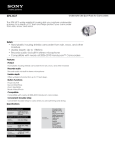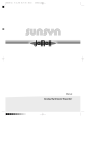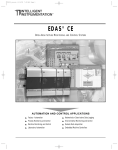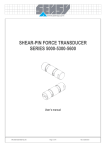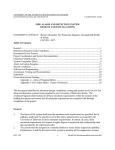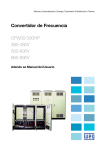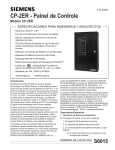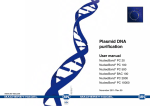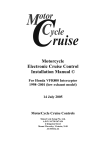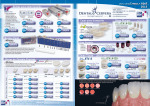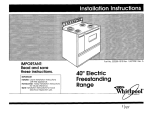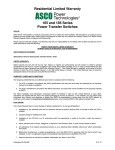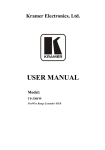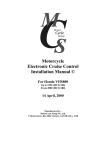Download MODEL PB-1191 Linear Smoke Detection System
Transcript
Cerberus Division CERBERUS PYROTRONICS™ MODEL PB-1191 Linear Smoke Detection System Operation and Installation Manual Siemens Building Technologies, Inc. 8 Fernwood Road Florham Park, New Jersey 07932 P/N 315-095424-3 Siemens Building Technologies, Ltd. 50 East Pearce Street Richmond Hill, Ontario L4B 1B7 CN PB-1191 Beam Detector Overview Figure 1 PBA-1191 Characteristics • • • • • • • • • • • • • Microprocessor-controlled signal processing Suitable for surveillance ranges from 17 to 280 feet Operates according to the principle of light-attenuation by smoke Response behavior selectable In 3 sensitivity stages Automatic digital compensation of ambient Influences High immunity to extraneous light Transmitter and receiver installed in the same housing Easy installation, adjustment, and commissioning Two-wire installation Comprehensive accessories New diagnostic capabilities with fuzzy logic Efficient signal processing algorithms with application-specific characteristics Comprehensive EMC concept based on the latest technologies enables the detector to be installed in difficult environments • Integrated multi-coincidence circuit suppresses extreme electrical and optical noise signals • Automatic and comprehensive self-test design 1 PB-1191 Beam Detector Design The PB-1191 linear smoke detector has the following components: • Base PBB-1191 consisting of: – Terminal support with terminals The base housing features six PG16 tapped cable inlets. • Detector module PBA-1191 consisting of: – Transmitter – Receiver – Lens – Electronics Insert the plug-in detector module just prior to alignment and commissioning. Align the Iens to the reflector by setting the adjustment on the PBL-1191. Reflectors Different reflectors are available for different distances: – 17ft to 99ft – 99ft to 164ft – 164ft to 214ft – 214ft to 262ft – 66ft to 280ft Reflector foil PBR-1193 (I0 x 10cm) 1 pc. Reflector foil PBR-1192 (20 x 20cm) 1 pc. Reflector foil PBR-1192 (20 x 20cm) 4 pcs. Reflector foil PBR-1192 (20 x 20cm) 9 pcs. Prism made of glass PBR-1191 (cat's eye) 1 pc. Short distance filter For shorter distances between 17ft and 33ft, use an additional short distance filter as listed below: – 17ft to 26ft – 23ft to 33ft PBF-1191B PBF-1191A Accessories: • Detector heater PBH-1191 protects against condensation of the lens Auxiliary tools: • Detector adjustment set PBL-1191 consisting of: – Adjustment device – Test filter – Target device 2 PB-1191 Beam Detector Operating principle The transmitter (IRLED) emits an invisible infrared (IR) pulse through the transmitter lens. The IR pulse crosses over the measuring section and reaches the reflector located opposite the detector. The reflector deflects the IR pulse back to the point of origin. The receiver lens directs the reflected IR pulse to a silicon photodiode. The resulting electrical signal is evaluated by the electronics. Receiver Coverage Area Transmitter Reflector PBR-1191 Detector PBA-1191 Figure 2 Linear smoke detector without smoke If smoke penetrates the measuring section, part of the light beam is absorbed by the smoke particles while another part is scattered by the smoke particles; that is, the light beams merely change direction. The remaining light reaches the reflector. The remaining light is then reflected and once again passes through the measuring section and is further attenuated. Thus only a small portion of the beam reaches the receiver and the signal (S smoke) becomes smaller. Scattering Scattering Light Beam Absorption Smoke Particles Scattering Figure 3 Measuring principle of the linear smoke detector with smoke Attenuation = Absorption + Scattering 3 PB-1191 Beam Detector Technical Data Parameters Operating voltage Symbol Unit Value min. Ub V 18 typ. max. Conditions 28 (quiescent) Umax V 30 Switch-on current Ie mA 2.8 Operating current (quiescent condition) Ib mA Alarm voltage at I A = 1 ... 10mA UA V 5 11 Maximum permissible voltage 1.5 2.8 Alarm current at U b = 24V IA mA 40 75 Reset voltage UR V 2 6 Reset time (U R = 2V) tR s Distance between detector and L FT 2 17 280 reflector Response sensitivity reduced standard increased D1 Compensation (if beam is attenuated) % % % % Compensation speed %/h Self-test interval min. Response indicator Voltage Current Uie Iie Electromagnetic compatibility Operating temperature Ta V mA 50 4 15 3 V/m 50 C -25 O Humidity <30OC >30OC 6 60 1MHx...1GHz +60 <95% rel <29g/m3 Storage temperature Tl Detector heater (optional) Supply voltage Operating current UH IH (maximum 1 detector per detection line) 4 Attenuation of the beam (See TABLE on page 22.) 65 50 30 C -30 +75 VDC mA 20 33 30 50 O Transient condensation allowed Regulated DC PB-1191 Beam Detector Design and Principle of Operation Detector Short Distance Filter Sighting Device (mirror with backsight) Sighting device (foresight) Receiver Lens Locking Screw Knurled Screw For Horizontal Adjustment Knurled Screw For Vertical Adjustment Locking Screw Transmitter Lens Program Switch Detector Heater Terminal Reed Contact (initialization) Connector for Adjustment Device Response Indicator Figure 4 The Detector Structure of the infrared beam The infrared beam emitted by the transmitter to the reflector is not a strictly parallel bundle of rays. It exhibits a certain degree of scattering which makes it conical in shape. The radiation energy decreases as you move towards the outside edges of the beam and can be divided into the three regions: • effective • core • scattered The reflector retransmits the received light. 5 PB-1191 Beam Detector Manual Effective region Core region Scattered region Detector PBA-1191 Reflector PBR-1191 Figure 5 Structure of the infrared beam • The effective region corresponds to the ribbon connecting transmitter, reflector and receiver. • The core region contains sufficient radiation energy to operate the system. • The energy in the scattered region is not sufficient to ensure reliable operation of the system. Reflector PBR-1191 5 ft. Detector PBA-1191 280 ft. Figure 6 Diameter of the core region Alignment Possibilitites The infrared beam can be adjusted by 10° increments horizontally and in 5° increments vertically from the center axis. When selecting the optimum mounting location, remember that this adjustment range can be fully used. Experience has shown that the detector and reflector should be arranged as parallel as possible especially with distances of >162.5 feet, as this makes adjustment simpler. Detector PBA-1191 10° Reflector PBR-1191 44 ft. 10° 44 ft. 280 ft. Figure 7 Horizontal adjustment range of the optical system - max. 10° each side of the axis 6 PB-1191 Beam Detector Manual Reflector PBR-1191 Detector PBA-1191 22 ft. 5° 5° 22 ft. 280 ft. Figure 8 Vertical adjustment range of the optical system - max. 5° above and below the axis Note: One rotation of the knurled screw moves the beam at 280 ft. approximately 3 ¾ ft. Reflectors Retroreflectors reflect the received light beam in parallel to the latter. For this reason the retroreflector does not have to be installed parallel to the detector. Also vibrations and distortions of the reflector mounting wall do not cause any problems. Another advantage is that any extraneous light is also reflected in its own direction and consequently does not reach the receiver. Reflector Reflector max. + 20° max. + 20° Reflector Figure 9 The reflector can be mounted inclined a maximum of ± 20O in all directions PBR-1191 prism The retroreflecting prism has the shape of a pyramid whose lateral faces are formed by isosceles orthogonal triangles. Light beams entering through the base are completely reflected twice on the lateral faces and reflected back through the base. The prism is installed in a housing that is identical to the one used for the detector base. The reflector is equipped with a reflector heater. If condensation is possible, connect the heater to a 24V supply. 7 PB-1191 Beam Detector Manual Light beam Figure 10 PBR-1191 reflector and reflection principle PBR-1192, PBR-1193 reflector This reflector consists of microprismatic elements that are formed by transparent, synthetic resin sealed to a plastic substrate. Compatibility COMPATIBLE EQUIPMENT System 8 Zone Module System - 3 ZB-35 MXL CZM-4 MXL-IQ CZM-4 PXL PCM-1 PZE-4B SXL-EX SZE-4X PB-1191 Beam Detector Manual Planning Fundamentals of planning The linear smoke detector PBA-1191 is ideal for certain applications. Use it to supplement or replace point-type smoke detectors. Refer to the Fields of Use table for suitable applications. FIELDS OF USE Very Suitable: Suitable: Large and high halls Aircraft hangars Cable and energy ducts Churches Buildings with artwork ceilings of historical interest Rooms with complex ceiling sructures Rooms with strong air currents Heavy soiling of point detectors (textile and wood processing) Monitoring at different levels Expensive installation and maintenance of point detectors, for example: -- in sawtooth roofs -- very high rooms -- where point detectors would have to be suspended at a lower level Underground garages >9ft high (min) Computer rooms Under floor Above ceiling Corridors Inner courtyards (malls) Open-plan offices Cross zone releasing appliances In combination with flame detectors Operating conditions The distance between the PBA-1191 and the reflector must be between 17 ft and 280 ft. - There must be a permanent line of vision between the PBA-1191 and the reflector. Care should be taken to ensure that the IR beam is not interrupted by moving objects such as overhead cranes, etc., which can lead to trouble signals. - If point detectors cannot be used because of the interfering effects of smoke, steam, or dust, note that the PBA-1191 will only solve the problem in certain cases. - Avoid frontal incidence of sunlight, light from halogen lamps, etc. on the PBA-1191. - Always mount the PBA-1191 in the vicinity of the ceiling (See Figure 11 for distances). The detector placement must not be too close to or too far from the ceiling. - The PBA-1191 is also suitable for very high rooms. As a supplementary measure, install additional PBA-1191s at different levels and/or use additional flame detectors. 9 PB-1191 Beam Detector Manual Monitoring areas with flat ceilings Min. spacing between two parallel beams determined by distance PBA-1191 and reflector (See Figure 20) Distance between PBA-1191 and reflector 17 - 280 ft. Max. distance from ceiling 1 ft. for rooms <33 ft. high (See Figures 21 & 22) Max. width of monitored area determined by height of room (See Figure 23) min 1 ft. Figure 11 Detector layout in areas with flat ceilings Monitoring areas with sloping ceilings To be defined as sloping, a ceiling must have an angle of inclination of at least 11 O which corresponds to >7.0 inch/yard. With gable roofs which have a slope of >0.5, always arrange a monitoring beam in the gable area. Additional PBA-1191s on the slope of the ceiling The number of PBA-1191s required results from the maximum permissible monitoring width shown in Figure 23. 1/4 10 1/4 1/4 1/4 Figure 12 Arrangement with 3 monitoring beams on a sloping ceiling PB-1191 Beam Detector Manual 1/3 1/6 1/6 1/3 Figure 13 If the ceiling slopes only slightly (N <0.5), the monitoring beam in the gable is unnecessary Both distances are determined by height of the room (See Figure 23.) Height of room When the sides of the roof are unequal, the unit must be displaced from the center towards the less steep side. Figure 14 Positioning underneath unequal sloping ceilings With sloping ceilings the smoke is channeled into the gable, resulting in an increased smoke concentration in this area. Therefore, the monitoring width for each PBA-1191 can be increased according to Figure 23. 11 PB-1191 Beam Detector Manual Monitoring areas with beam constructions Note that the term beams, also covers such structures as air conditioning ducts which are mounted up to 0.5 ft below the ceiling. Layout underneath beam construction If the beam construction is less than 20% of the total height of the room, the units of the linear smoke detector can be mounted below the beams as indicated in Figure 15. min. 1 ft. a 100% <20% Note: When calculating the width of the monitored area, only the distance up to the beam construction counts as the height of the room. a: Height for determining max. width of monitored area Figure 15 Detector layout underneath beam construction Layout within the beam area When the beam construction is more than 20% of the total height of the room, then the beams can be considered as room dividers and each section must be individually monitored. 100% <20% Note: When distance exceeds maximum monitored area, mount more than one linear smoke detector per section. Figure 16 Detector layout within beam construction 12 PB-1191 Beam Detector Manual Detection of smoldering fire in high rooms 10 ft. up to 60% of the room height PBA-1191 Reflectors In order to detect smoldering fires with weak thermal current even in high rooms, the second IR beam must be arranged at the assumed height of the spread of smoke of a smoldering fire. Figure 17 Detection of smoldering fires in high rooms with two linear smoke detectors Guideline for distances between PBA-1191 and reflector Distance PB reflector 17 — 33 ft 33 — 99 ft 99 — 164 ft 164 — 214 ft 214 — 262 ft 66 — 280 ft Types and number of reflectors Short distance filter + 1 PBR-1193 1 PBR-1193 1 PBR-1192 4 PBR-1192 9 PBR-1192 1 PBR-1191 If a number of reflectors are used, they must be arranged close together and in the form of a square. Distances are approximate; they depend on detector and reflector tolerances and can easily vary by a few yards. The important thing is that sufficient signal strength is achieved. Penetration of panes of glass With the reflector principle, the penetration of panes of glass is subject to certain restrictions. • Panes of glass must be absolutely smooth, clear and firmly installed. • Panes of glass must never be positioned at an angle to the optical axis, in which the pane of glass has the effect of a mirror and can reflect the beam back to the receiver (angle of incidence = angle of reflection). • No more than 2 panes of 3/16 inch glass may be penetrated. • Each pane of glass reduces the distance by 66 feet. 13 PB-1191 Beam Detector Manual PBA-1191 Pane of glass Partial light scatter Partial light scatter PBR-1191 PBA-1191 Pane of glass PBR-1191 min. 10° CORRECT - THE RECEIVER IS NOT AFFECTED INCORRECT - THE RECEIVER IS AFFECTED Figure 18 With the penetration of panes of glass, check the angle in relation to the optical axis Glass wall Partial light scatter Partial light scatter PBA-1191 PBR-1191 correctly positioned PBR-1191 incorrectly positioned PLAN PBA-1191 PBR-1191 Glass wall FRONT ELEVATION PBR-1191 correctly positioned PBR-1191 incorrectly positioned PBA-1191 Glass wall Figure 19 Application example for the penetration of pages of glass 14 PB-1191 Beam Detector Manual Minimum distances between two pairs of detectors The monitoring beam must not be mounted closer than 1 ft. to the ceiling, walls, installations, and stored material. In order to prevent the mutual interference of two or more PBA-1191 detectors where there is an increasing distance between PBA-1191 and reflector, maintain an ever-increasing transverse distance between PBA-1191 and reflector. Figure 20 Minimum distance between two parallel IR beams Beam spacing from the ceiling In order for the IR beam to detect the smoke, it is normally mounted immediately beneath the cushion of warm air. The higher the room, the further away the PBA-1191 and the reflector should be mounted from the ceiling. Figure 21 Distance from IR beam ⇒ flat ceiling (N < 0,2) 15 PB-1191 Beam Detector Manual NOTE: The steeper the gable roof, the greater the distance must be between the IR beam in the gable and the ridge. Figure 22 Distance from IR beam ⇒ sloping ceiling (N > 0,2) Maximum monitoring width The monitoring width can be increased with increasing room height. Figure 23 Monitoring width dependent on the room height If the monitoring beam is set at a low level in order to detect a smouldering fire, use the distance between the floor and detector instead of the room height. However, choose a narrower monitoring width to cover increased risks. 16 PB-1191 Beam Detector Manual Measures against condensation If the PBA-1191 or the reflector is mounted on cool outside walls or in rooms in which there is high humidity and a rapid increase in temperature (e.g. sunshine on a non-insulated roof), use the detector heating unit PBH-1191. If condensation on the front cover causes troubles or false alarms, or for short distances, use the reflector PBR-1191 with built-in heating. Installation locations When installation locations are rigid and vibration-free, large temperature fluctuations (e.g., between day and night) have only a slight influence on steel girders and do not greatly affect the building structure. However, if the installation location is not rigid, the closely bundled infrared beam can drift from the receiver and cause an alarm or trouble signal. Unstable installation locations include: • • • the walls of rooms constructed of steel which expand and contract due to the temperature coefficient of steel masonry walls upon which a steel roof has been constructed non-bonded wooden beam construction In the cases listed above the PBA-1191 must be mounted on the rigid structural element, while the reflector can be mounted on the unstable wall. PBR-1191 PBA-1191 INCORRECT Figure 24 Deflection of the IR beam caused by heat on the steel roof PBA-1191 PBR-1191 CORRECT Figure 25 Possible solution: mounting the PB-1191 on the stable surface and mounting the reflector on the unstable wall 17 PB-1191 Beam Detector Manual Accessibility The PB-1191 must always be easily accessible in high halls for commissioning and servicing. Suitable equipment for this purpose includes fixed ladders, catwalks, etc. or safe mobile equipment such as stacker trucks, sky-workers etc. Figure 26 Difficult and dangerous work using a ladder Figure 27 Precise and safe work using a permanent plafform 18 PB-1191 Beam Detector Manual Installation Mounting 6" 5 3\8" Surface mounting directly on the wall (minimum clearance to ceiling and other obstacles at least 1 ft) 3/16" 5 3/8" Base PBB-1191 4 5\8" 3/16" PG16 Detector module PBA-1191 Mounting plane PBB-1191 NOTE: The response indicator should always be at the bottom. Figure 28 Installation of the PBA-1191 6" 5 3\8" Detector module PBA-1191 3/16" Reflector heater 5 3/8" 1¾" 2 5\8" PG16 Mounting plane PBR-1191 Figure 29 Installation of the PBR-1191 Reflector 19 PB-1191 Beam Detector Manual Wiring The detector is installed with a twisted 2-wire line from base to base. The PBB-1191 base contains one terminal block with 6 terminals for connecting the detector to the line and for connecting the external response indicator. The terminal block incorporates a slide switch jumper which places the end of line device in the circuit for initial continuity check. When the detector is first installed, this jumper is automatically disengaged and remains that way. Caution: Slide switch must be intact and engaged or trouble conitions will not be annunciated. The opposite terminal block is supplied for the detector heater. Short distance filter Short distance filter Figure 30 Insert short distance filter for distances < 33 feet Detector heater In the event of danger of condensation, the installation of the detector heater is recommended NOTE: Supply voltage 24V is necessary. The opposite terminal block is supplied together with the detector heater and is used for connecting the detector heater. 20 PB-1191 Beam Detector Manual Detector heater connection Connection adjustment unit Figure 31 Connection of the dector heater Connection RLI-1 or RLI-2 End of line device To UL Listed Siemens Building Technologies, Inc. Control Panel Response Indicator MB = RED pulse signal (for adjusting the lenses during detector production) Z = auxillary terminal Auxillary supply for detector heater (optional) 24V NOTE: Only one detector may be connected per zone circuit. Figure 32 Connection diagram 21 PB-1191 Beam Detector Manual Commissioning Settings • Remove the detector cover. • Set the DIP switches. The detector has 3 sensitivity settings - REDUCED, STANDARD, and INCREASED. Set the response threshold with DIPswitch S1 and S2. The transmitter intensity (strong, weak) is set with DIPswitch S3. The S3 DIPswitch, which governs the transmitter intensity is set to STRONG by default. If the signal amplitude is too high (display on the adjustment unit: Range = 13, signal > 50), the transmitter can be set to WEAK. If the measurement section is < 33 ft., a supplementary filter must be installed. Function S1 Reduced Sensitivity (65%) (See TABLE below.) off S2 S3 S4 S5 S6 on Standard Sensitivity (50%) (See TABLE below.) on Increased Sensitivity (30%) (See TABLE below.) on on off on Weak Transmitter Signal Strong Transmitter Signal off on Conventional Reserved S6 OFF Fault at beam interruption (<30s or >60s) Beam Distance off Allowable Sensitivity Setting 17 ft. to 33 ft. Increased only 33 ft. to 98 ft. Standard only 98 ft. to 164 ft. Standard and Reduced 164 ft. to 280 ft. Reduced only Figure 33 Settings 22 PB-1191 Beam Detector Manual Preliminary adjustment • Install the alignment device on the detector. The mirror and the front sight must be installed without play! • Unfasten the locking screw. • Align the detector lens to the reflector. The detector lens can be adjusted with the knurled screws. Check by using the mirror and front sight - the target center and the apex of the sight must be within the circle. • Apply zone power. • Connect the adjustment unit to the detector. Note: Install a new battery. Switch the adjustment unit to ON and AUTO-RANGE. The correct range is measured automatically. When the mechanical adjustment is correct, a signal >2 shows on the adjustment unit. This signal changes in large increments when the knurled screw is turned. • Remove the aiming device. Mirror with backsight Eye Foresight Locking screw Knurled screw for horizontal adjustment Locking screw Reflector Knurled screw for vertical adjustment Figure 34 Mounting the aiming device and aligning the detector to the reflector 23 PB-1191 Beam Detector Manual Final Adjustment • Set the switch on the adjustment unit to AUTO-RANGE. • Using the knurled screws, fine-adjust the detector lens to display the maximum level in the RANGE display. Note: The knurled screws should be turned slowly in order to avoid large signal jumps. • When the maximum value is obtained, (it must be between min. 4 and max. 13) set the switch to FIX-RANGE. The range level is now programmed into the detector to set the internal amplifiers. • Adjust the knurled screws to display the maximum level in the SIGNAL display. Caution: If the signal value can be adjusted to >60, the range level was not adjusted to its maximum. Switch back to AUTO-RANGE and readjust to the maximum range level. Then repeat the signal level adjustment. The RANGE and SIGNAL levels on the adjustment unit should both be set to the maximum. • Engage the locking screws. • Switch the adjustment unit to FIX-RANGE. Connection adjustment unit Figure 35 Front plate of the adjustment unit • Cover the reflector. Completely cover the reflector with a dark cover. The signal should decrease to <2. If this is not the case, the detector has not been aligned to the reflector but to a reflecting obstacle in the environment of the measurement section. Repeat the adjustment procedure. 24 • Disconnect the adjustment unit from the detector. • Reinstall the detector cover. PB-1191 Beam Detector Manual Initialization To initialize the detector, activate a reed relay located near the internal response indicator with the supplied magnet. A flashing response indicator signals initialization. Reed relay rear of the response indicator Magnet Figure 36 Initialization with the magnet During the initialization, the working range of the electronics (RANGE), the compensation value, all smoothing algorithms and diagnostics, and the staus are set to an initial value. All required thresholds are calculated. At the same time a self-test is performed. • lnitialization with the magnet. Place the magnet directly behind the response indicator to activate the Reed relay (Black or red point = magnet). As soon as the response indicator flashes, the compensation value is formed (approximately 30 sec.). Do not interfere with the measurement during this time. When the initialization is completed, the response indicator turns off. If any procedural error has been made, a new initialization can be started at any time with the magnet. • Test alarm with test filter. Place the test filter immediately in front of the detector and cover the entire measurement window. When an alarm is triggered, the response indicator turns on after approximately 10 seconds. • The commissioning is now completed. 25 PB-1191 Beam Detector Manual Troubles / Overhaul Trouble Removing the detector triggers a trouble condition (zone line interruption). Blocking the IR Beam also triggers a trouble condition (in approximately 1 minute). Reflection If a reflective surface comes too close to the coverage area or near the detector, a reflection can occur. As a result, the measured value increases significantly above the compensation value and remains at that level. The system reports a trouble to the control unit. Functional check/ overhaul The detector self-test automatically subjects the PBA-1191 to an extensive electronic functional check. Nevertheless it is necessary to physically check the functions on site at regular intervals by triggering the detector with a suitable test filter (usually once per year). Detectors that do not respond or which are mechanically damaged must be replaced. All detector covers and reflectors should be cleaned regularly with a soft piece of cloth which is either dry or soaked with a mild soap solution, depending on the environmental conditions and severity of contamination at the installation site. Do not use any solvents or pressurized liquids. 26 Siemens Building Technologies, Inc. 8 Fernwood Road Florham Park, New Jersey 07932 P/N 315-095424-3 Siemens Building Technologies, Ltd. 50 East Pearce Street Richmond Hill, Ontario L4B 1B7 CN




























